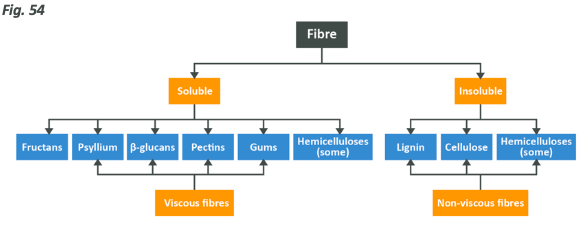What are the benefits of fibre?
As you have seen, many fibre types have different properties. They may be more or less viscous, more or less fermentable, more or less adsorptive and more or less soluble. Rather than list the benefits of each fibre it is more practical to list the benefits of each fibre ‘class’.
Solubility
Solubility is perhaps the most broadly-recognised property of fibres. Soluble fibres are those that will become a solution in hot water, whereas insoluble fibres will not. Very generally speaking, soluble fibres will delay gastric emptying time and delay transit time through the gut, whereas insoluble fibres can increase faecal bulk thus increasing transit time. The benefits provided by all of this will be discussed later.
Viscosity
Viscosity denotes the hydration potential of a fibre. Viscosity is not tied to solubility, meaning an insoluble fibre can still ‘soak up’ water without becoming a solute. The graphic below indicates the relationship between the 2.

Viscous fibres have a number of benefits, namely:
- They delay gastric emptying. By hydrating and forming thick gels, viscous fibres slow the release of chyme to the duodenum. This slowed gastric emptying results in a greater duration of postprandial satiation and can therefore help with hunger during periods of caloric restriction
- Reduced digestive enzyme function. This happens in two ways. Firstly, the viscosity of the chyme simply restricts the ability of enzymes to come into contact with foods, thus impairing nutrient digestion. Furthermore, some fibres such as gums are able to directly impair hydrolysis of proteins and lipids. This should be carefully considered by those with very high protein and fibre intakes
- Decreased nutrient diffusion rate. Thanks both to delayed gastric emptying, and then slow movement of nutrients through chyme that has been emptied into the duodenum, glucose enters the bloodstream far more slowly than it otherwise would. This has the ability to reduce the glycaemic response and reduce insulin secretion so should be carefully considered by diabetics who may benefit from these effects. Supplemental fibre (specifically guar gum and pectin) appear most effective